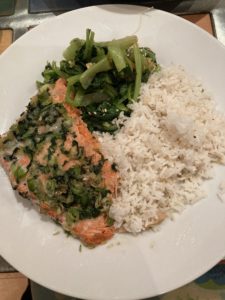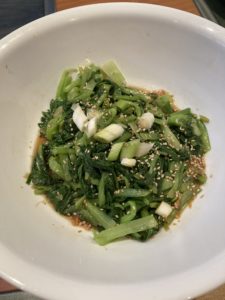
I am a huge fan of Korean food — I love the soy, the sesame, the pungently spice gochujang with a hint of sweetness, the kimchi.
I stumbled across some Korean-style recipes while scrolling through social media; later, I couldn’t begin to find them again if my life were hanging in the balance, but I remembered the basic ingredients and procedures, and was able to use these ideas as inspiration for a delicious and pretty simple dinner.
I used sockeye salmon because I had a slab in my freezer; it is a leaner fish than other salmon varietals and therefore must be cooked “low and slow” until it is just barely done. A bit rare in the middle is recommended, but if you can’t stomach that this method will keep the fish from drying out even if you take it nearer to well done (gasp!).
And you can use more or less any fish for this recipe — cod, snapper, bass, fluke, etc. — even something delicate like flounder — just be sure to adjust the time in the oven so you don’t overcook it.
Cilantro-Scallion-Ginger Salmon
Serves 2
1 tablespoon canola or vegetable oil
2 scallions, sliced
1 knob ginger, about 1 inch, grated
1 handful cilantro, rinsed well and coarsely chopped
2 salmon filets, about ¾ pound total
½ lemon
Salt and pepper
Heat your oven to 275 degrees F.
In an ovenproof skillet, heat the oil and sauté the scallions, ginger and cilantro until cooked, about 5 minutes. Meanwhile, spritz the salmon with lemon juice and sprinkle it with salt and pepper.
Push the scallion mixture to the perimeter of the pan and place the salmon filets, skin side down, into the center of the skillet. Spoon the scallion mixture along with any liquid that it has released over the salmon to coat, or insulate the fish (this is what keeps it from drying out). Bake the fish for about 25-30 minutes until done.
Garlic-fried Rice
Serves 2
I used basmati for this, which is not traditional for Korean cuisine, but that’s what I had in the pantry and it worked just fine.
My recollection of the recipe, and indeed with all cooking instructions for fried rice recipes, is to use leftover rice that has had the chance to sit in the fridge overnight and dry out. Some recipes go so far as to suggest ordering extra rice when you do takeout so you have the proper rice on hand and the optimal time to allow it to sit overnight.
Realizing that, and deciding to make this dish sometime around 2 p.m., I cooked the rice and let it sit out in a shallow bowl, uncovered, for a few hours to enable the moisture to escape. The rice came out really well, but I have a hard time believing that anything sautéed in garlic-infused oil and topped with crispy garlic would be anything less than intoxicating, so my advice to you, even if you are starting this late in the day, is to go for it.
2 cups cooked rice
3 tablespoons canola oil
8 cloves garlic, crushed
Salt and pepper to taste
1 scallion, sliced, for serving
In a large, nonstick skillet, heat the oil and garlic over medium. Stir frequently, until the garlic begins to crisp and brown. Watch it carefully; you want it toasted and golden, not burnt. Remove the garlic from the oil and drain it on paper towels. Set it aside.
Pour the rice into the skillet with the oil and press it down, almost like a pancake. Allow it to sizzle and cook and, after a few minutes, scrape it up and turn the rice over, pressing the rice down again. Repeat this process several times until all of the rice seems well coated and slightly fried. This will take about 10 minutes. When done, sprinkle the toasted garlic over the top of the rice, stir to distribute and top with scallions.

Sesame-Soy Spinach Salad
Serves 2
We served this dish cold as a salad, but as we ate it, we both thought it would have been better hot.
Full disclosure: We had this as a side dish on a rather chilly night, and we probably assessed it based on external factors, but as the weather warms and we crave lighter, cooling fare, a cold version of this might be just the thing. And, if not, you can limit the time the greens spend in the ice bath so they stay closer to room temperature, or pop the dish in the microwave before you serve it.
One other note on the spinach: This could be made with just about any green — bok choy, kale, collards, escarole, pea leaves, et cetera. Just be sure to vary the cooking time so the greens cook through. Kale and collards will take about 10 minutes in the water, while bok choy will only need about 2, and pea leaves just a quick dip.
1 large bunch spinach
1 teaspoon soy sauce
1 teaspoon sesame oil
1 clove garlic, crushed
1 teaspoon sesame seeds
Bring a large pot of salted water to boil. Dump the spinach into the boiling water and cook it for about 1 minute until bright green and just done. Drain the spinach and immerse it in an ice water bath immediately.
After the spinach cools slightly, about 1 minute, pour it into a colander and press out the excess water. While the spinach continues to drain, mix the soy, sesame oil and garlic in the bottom of a medium-sized bowl.
Remove the spinach from the colander, coarsely chop it, place it in the bowl with the dressing, and toss. Sprinkle it with sesame seeds.
Serve chilled, at room temperature or reheated as desired.






